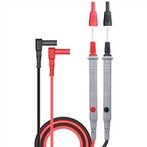What does it mean when a pH meter displays the wrong solution?
Firstly, we need to understand the working principle of a pH meter. A pH meter is an instrument that determines the pH value of an aqueous solution by measuring the concentration of hydrogen ions (i.e. acidity) in the solution. The pH meter uses a glass electrode and a reference electrode to measure the pH value by the potential difference between the electrode and the aqueous solution. When the reference electrode and glass electrode come into contact with an aqueous solution, the potential difference they generate is proportional to the concentration of hydrogen ions in the solution, allowing for the calculation of the pH value.
When the pH meter shows an incorrect solution, it means that the pH meter cannot correctly read the pH value of the solution. This may be due to the following reasons:
1. The glass electrode is contaminated or damaged. Glass electrodes have high sensitivity and accuracy, and are highly sensitive to impurities or pollutants. If the glass electrode is contaminated or damaged, it will not be able to correctly read the pH value.
2. Reference electrode failure or corrosion. The reference electrode is used to provide the potential opposite to the measuring electrode to determine the pH value. If the reference electrode fails or corrodes, it cannot provide accurate potential.
3. The pH meter is not calibrated correctly. To ensure the accuracy of the pH meter, regular calibration is required. If the pH meter is not calibrated correctly, it cannot provide accurate readings.
4. There are strong acids or bases present in the solution. If there are strong acids or bases in the solution, they may cause damage to the electrodes of the pH meter and affect the accuracy of its readings.
5. In the case of encountering the wrong solution, we need to carefully check whether the electrodes of the pH meter are contaminated or damaged, and check whether the reference electrode is malfunctioning or corroded. At the same time, we also need to ensure that the pH meter has been calibrated correctly and exclude the possibility of strong acids or bases. If none of the above measures can solve the problem, it may be necessary to replace the electrode or contact the instrument manufacturer for further repairs.






